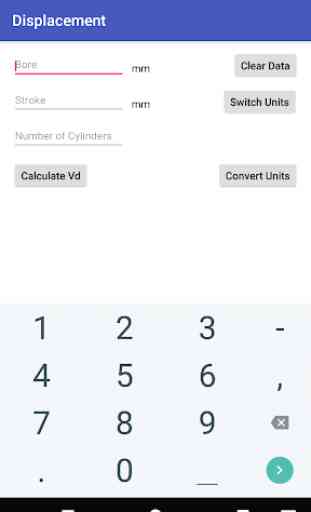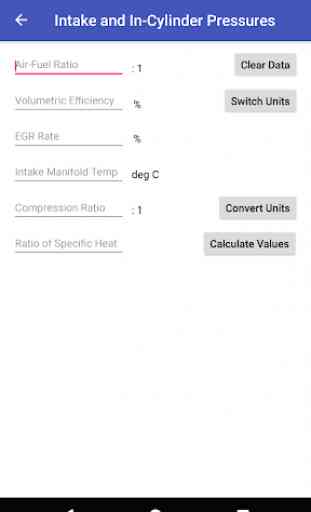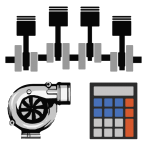Engine Performance Calculator
This application contains four sequential pages with calculations commonly used in engine performance development of four-stroke internal combustion engines (spark-ignited and diesel). This application works in both metric and English units.
The application pages are organized as follows:
1. Displacement: The user defines the engine displacement by specifying bore, stroke, and number of cylinders.
2. Operating Point: The user defines the operating point of interest by specifying engine speed and load. Load may be specified as power, torque, or BMEP. The remaining parameters are then calculated.
3. Fuel Flow: This page calculates fuel flow based on user inputs for efficiency and lower heating value of the fuel. Efficiency may be specified as BSFC or fuel conversion efficiency (i.e. thermal efficiency). The remaining parameter is then calculated. The info button provides LHV reference values for common fuel types.
4. Intake and In-Cylinder Pressures: This page calculates air flow, EGR flow (if applicable), intake manifold pressure required, and estimated peak firing pressure, from user input parameters of air-fuel ratio, volumetric efficiency, % EGR (which may be left blank), intake manifold air temperature, compression ratio, and ratio of specific heats (i.e. gamma) during the compression stroke, which is typically in the range of 1.30-1.40.
Additional notes:
Intake manifold pressure is calculated from ideal gas law, and serves as a relative indication of compressor requirements for turbocharged engine applications. Please note that intake manifold temperature should take into account mixing of intake air with EGR. Estimation of peak firing pressure comes from calculation of motoring pressure, based on initial pressure of intake charge (i.e. intake manifold pressure), compression ratio, and gamma, with approximately 30 bar added to account for combustion event. Please note that this estimated value should be used for relative comparison purposes only, as actual peak firing pressures will vary based on combustion mode, phasing, and duration.
The application pages are organized as follows:
1. Displacement: The user defines the engine displacement by specifying bore, stroke, and number of cylinders.
2. Operating Point: The user defines the operating point of interest by specifying engine speed and load. Load may be specified as power, torque, or BMEP. The remaining parameters are then calculated.
3. Fuel Flow: This page calculates fuel flow based on user inputs for efficiency and lower heating value of the fuel. Efficiency may be specified as BSFC or fuel conversion efficiency (i.e. thermal efficiency). The remaining parameter is then calculated. The info button provides LHV reference values for common fuel types.
4. Intake and In-Cylinder Pressures: This page calculates air flow, EGR flow (if applicable), intake manifold pressure required, and estimated peak firing pressure, from user input parameters of air-fuel ratio, volumetric efficiency, % EGR (which may be left blank), intake manifold air temperature, compression ratio, and ratio of specific heats (i.e. gamma) during the compression stroke, which is typically in the range of 1.30-1.40.
Additional notes:
Intake manifold pressure is calculated from ideal gas law, and serves as a relative indication of compressor requirements for turbocharged engine applications. Please note that intake manifold temperature should take into account mixing of intake air with EGR. Estimation of peak firing pressure comes from calculation of motoring pressure, based on initial pressure of intake charge (i.e. intake manifold pressure), compression ratio, and gamma, with approximately 30 bar added to account for combustion event. Please note that this estimated value should be used for relative comparison purposes only, as actual peak firing pressures will vary based on combustion mode, phasing, and duration.
Category : Tools

Related searches




